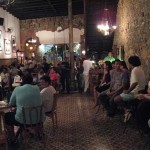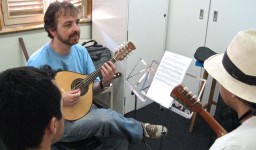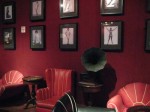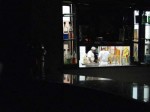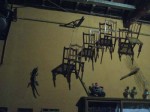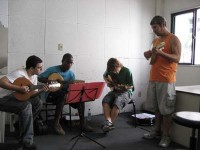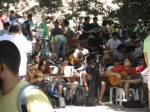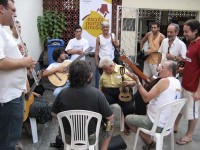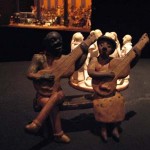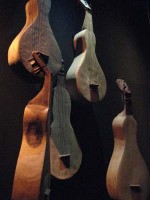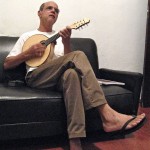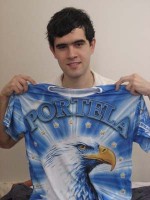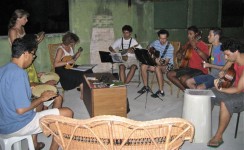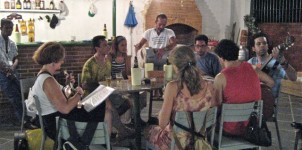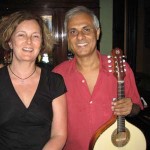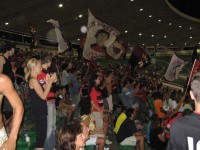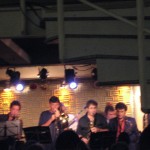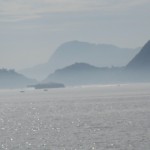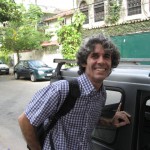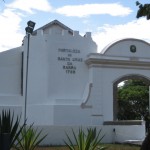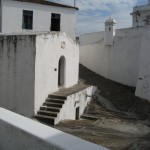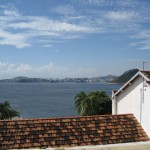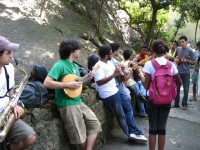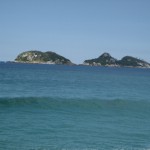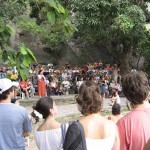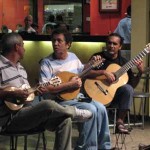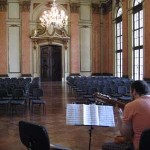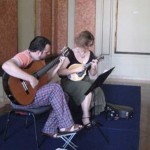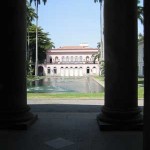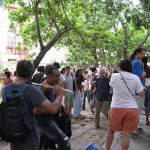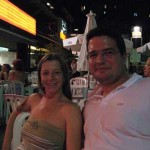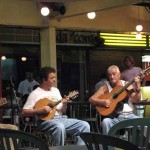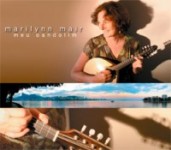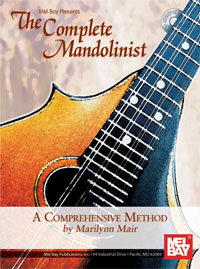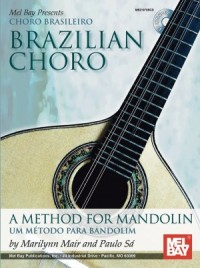 I feel like it’s been ages since I wrote a log. But when you have visitors time flies, and my boy Nate and my great friend Betty have been visiting so while there has been lots to report, there has been little time to report it. I ended last log on April 9th, and April 10th was the day of the “big concert” with Hamilton de Holande and Yamand Costa playing at the famous old hall Canacao, near my apartment. I was going to skip it and just go to the jam at Trapiche, as it’s the last one for my friend Bonnie who is leaving for Vermont on Wednesday. But when will I ever see these
I feel like it’s been ages since I wrote a log. But when you have visitors time flies, and my boy Nate and my great friend Betty have been visiting so while there has been lots to report, there has been little time to report it. I ended last log on April 9th, and April 10th was the day of the “big concert” with Hamilton de Holande and Yamand Costa playing at the famous old hall Canacao, near my apartment. I was going to skip it and just go to the jam at Trapiche, as it’s the last one for my friend Bonnie who is leaving for Vermont on Wednesday. But when will I ever see these  two together in the US? – never. So I get tickets for Nate and me.
two together in the US? – never. So I get tickets for Nate and me.
We decide to spend the afternoon walking around the Gloria neighborhood, but no sooner are we off the bus and walking up the first hill than Nate darts into a bar with soccer on the TV and comes back out to report that it’s a big game in Europe, Manchester vs an Italian team I think, so we plop down at the bar and order a quart of beer and 2 glasses. It seems like kindof a divey men’s bar, but there is a very properly-dressed older lady sitting at the bar having a cafezinho, so I don’t worry, it’s a neighborhood place. Nate’s team is losing badly when I have to leave to go meet my longtime email friend Sergio do Nascimento at the Carioca metro station. It’s the day after his birthday so I have a copy of my new CD for him. He  walks me by the Wiskeria Gouveia, known as Pixinguinha’s office while he was alive, and I take Sergio’s pic with the famous statue of P. It’s P’s birthday on April 23, and is officially “choro day” in Brazil in his honor. Sergio is a cheerful man – a really good bandolimist and unofficial choro historian. We have coffee and talk and he gives me a CD of old choro recordings that he has in his collection, and some old movies of Joel playing. It’s great to finally meet him after so many years and we’ll get together again soon.
walks me by the Wiskeria Gouveia, known as Pixinguinha’s office while he was alive, and I take Sergio’s pic with the famous statue of P. It’s P’s birthday on April 23, and is officially “choro day” in Brazil in his honor. Sergio is a cheerful man – a really good bandolimist and unofficial choro historian. We have coffee and talk and he gives me a CD of old choro recordings that he has in his collection, and some old movies of Joel playing. It’s great to finally meet him after so many years and we’ll get together again soon.
 Back home to meet Nate for the concert, but he calls to say that he got held up buying LPs and will meet me at the hall. As I’m waiting I get handed a flyer for a Choro-fest next week-end with 10 bands, 8 of whom I have CDs by. Can’t wait for that! Canacao is very formal and unlike American halls in that the whole center is full of tables with tablecloths and waiters are serving drinks and food. The setting is kindof like I imagine a rock concert in Las Vegas would be, with a lightshow and big
Back home to meet Nate for the concert, but he calls to say that he got held up buying LPs and will meet me at the hall. As I’m waiting I get handed a flyer for a Choro-fest next week-end with 10 bands, 8 of whom I have CDs by. Can’t wait for that! Canacao is very formal and unlike American halls in that the whole center is full of tables with tablecloths and waiters are serving drinks and food. The setting is kindof like I imagine a rock concert in Las Vegas would be, with a lightshow and big  screens on either side of the stage showing the performers. It’s jaw-dropping virtuosity and fast unison runs for most of the night, interspersed with a few sentimental tunes written by the performers. It’s interesting to see what it takes to put choro – a small-bar informal music – into a big concert venue, and of course to see these two virtuosos live. I’m glad I came, but part of me wishes I was at Trapiche with Bonnie. Both players are performing individually in the Choro-fest next week; it’ll be interesting to see what they do in a less-stylized setting.
screens on either side of the stage showing the performers. It’s jaw-dropping virtuosity and fast unison runs for most of the night, interspersed with a few sentimental tunes written by the performers. It’s interesting to see what it takes to put choro – a small-bar informal music – into a big concert venue, and of course to see these two virtuosos live. I’m glad I came, but part of me wishes I was at Trapiche with Bonnie. Both players are performing individually in the Choro-fest next week; it’ll be interesting to see what they do in a less-stylized setting.
 I get up early the next morning to meet Bonnie for coffee in the park by the Catete Palace to say good-bye. She says the session at Trapiche was great, and Beth Carvalo – her singing idol, was there just to listen and she got to talk to her. We promise to get together to play Brazilian music in the US. She was here for 3 months too, but started in January, and so is headed home with instruments for her samba band in Burlington. It’s Wednesday and lesson-day with Joel, so I head home and have breakfast with Nate. TaxiPaulo picks me up and surprises me with a CD of choro he’s copied from old LPs, including a play-back LP of Altimiro Carriliho. He’s signed the CD “Paulo, Seu Taxista Amigo”. The lesson goes well and afterwards Paulo drops me at Romulo’s for “regional” (choro band) “ensaio” (rehearsal). It’s a small group but we have a jolly time and afterwards guitarist Pablo and his friend Sandro drive me all the way home after much discussion amongst the boys debating the safely of me taking the metro home at that hour (~11:00 PM). On the drive Pablo says he’s been to my website and read it with his dictionary in hand. He says, in English, with a big smile, “Now I know all about your life.”
I get up early the next morning to meet Bonnie for coffee in the park by the Catete Palace to say good-bye. She says the session at Trapiche was great, and Beth Carvalo – her singing idol, was there just to listen and she got to talk to her. We promise to get together to play Brazilian music in the US. She was here for 3 months too, but started in January, and so is headed home with instruments for her samba band in Burlington. It’s Wednesday and lesson-day with Joel, so I head home and have breakfast with Nate. TaxiPaulo picks me up and surprises me with a CD of choro he’s copied from old LPs, including a play-back LP of Altimiro Carriliho. He’s signed the CD “Paulo, Seu Taxista Amigo”. The lesson goes well and afterwards Paulo drops me at Romulo’s for “regional” (choro band) “ensaio” (rehearsal). It’s a small group but we have a jolly time and afterwards guitarist Pablo and his friend Sandro drive me all the way home after much discussion amongst the boys debating the safely of me taking the metro home at that hour (~11:00 PM). On the drive Pablo says he’s been to my website and read it with his dictionary in hand. He says, in English, with a big smile, “Now I know all about your life.”
 Thursday morning I meet Paulo Sa downtown to go again to his class at the Villa-Lobos Conservatory. He’s talking to the students about choro interpretation and styles of different players, and when I chime in in Portuguese he looks surprised and says, in English, “Your Portuguese is much better!” And it is, from weeks of practice. He is arranging for Betty and me to come to Petropolis to visit while she is here, but unfortunately probably after Nate leaves. And where is Nate in this narrative, you may ask? Well, he has some friends from school and from Germany living in Rio and has met others, so is happily occupied doing things with them, and we hang out some every day as well. But since he’s here for 2 weeks it’s
Thursday morning I meet Paulo Sa downtown to go again to his class at the Villa-Lobos Conservatory. He’s talking to the students about choro interpretation and styles of different players, and when I chime in in Portuguese he looks surprised and says, in English, “Your Portuguese is much better!” And it is, from weeks of practice. He is arranging for Betty and me to come to Petropolis to visit while she is here, but unfortunately probably after Nate leaves. And where is Nate in this narrative, you may ask? Well, he has some friends from school and from Germany living in Rio and has met others, so is happily occupied doing things with them, and we hang out some every day as well. But since he’s here for 2 weeks it’s  good that he’s got his own world to explore as well as visiting mine.
good that he’s got his own world to explore as well as visiting mine.
There’s an early-evening concert at FINEP of Alvaro Carrilho, flutist brother of virtuoso flutist Altimiro, and uncle of Maurcio, backed by a band of Maurcio, Luciana Rabello, Maurcio’s wife Anna Paes, and his cousin Pedro Paes, a real choro family, playing all tunes written by Alvaro. Halfway through Alvaro’s grandson Pablo, who looks to be about 15, sits in on 6-string in Anna’s place. After the concert, Ray, Bonnie’s friend from Australia, comes over and introduces himself. He plays 7-string and is in my Rep class at Choro School, He’s here for 3 months too, and his stay ends in 2 weeks. He says he’s going to Carioca da Gema later, and I’d been thinking of it since Ronaldo said he was playing there, so I say I’ll meet him there in a couple of hours, around 9:30.
 Due to a mis-communication with TaxiPaulo, however, I don’t arrive until around 11:00, but find the party just getting going. The band includes the three Sousa brothers, Ronaldo on bandolim, Rogerio (who plays in No Em Pingo D’Agua) on 7-string, and Roberto (who says he really doesn’t play) on cavaquinho, along with Selsinho and some others on percussion, and two women singers who alternate. When I walk in the door I don’t see Ray, but Ronaldo sees me and greets me with a theatrical hug, introduces me to his family – brothers, wives, band girlfriends, and finds a place for me at the musician’s table before they start the next set. To “sambando” – the participle of the non-verb samba – is a Carioca bohemian way of life and the club is jumping. Soon I’m getting dance lessons from the girls, finally find Ray, and before I know it it’s 2:00 AM. I call TaxiPaulo to pick me up and we drop Ray off on the way. TPaulo has brought some of his old choro scores for me to copy – what a guy! I arrive home later than Nate for a change, and TPaulo sends me an email the next day kidding me about my new bohemian Carioca lifestyle. Which is, of course, soon to change.
Due to a mis-communication with TaxiPaulo, however, I don’t arrive until around 11:00, but find the party just getting going. The band includes the three Sousa brothers, Ronaldo on bandolim, Rogerio (who plays in No Em Pingo D’Agua) on 7-string, and Roberto (who says he really doesn’t play) on cavaquinho, along with Selsinho and some others on percussion, and two women singers who alternate. When I walk in the door I don’t see Ray, but Ronaldo sees me and greets me with a theatrical hug, introduces me to his family – brothers, wives, band girlfriends, and finds a place for me at the musician’s table before they start the next set. To “sambando” – the participle of the non-verb samba – is a Carioca bohemian way of life and the club is jumping. Soon I’m getting dance lessons from the girls, finally find Ray, and before I know it it’s 2:00 AM. I call TaxiPaulo to pick me up and we drop Ray off on the way. TPaulo has brought some of his old choro scores for me to copy – what a guy! I arrive home later than Nate for a change, and TPaulo sends me an email the next day kidding me about my new bohemian Carioca lifestyle. Which is, of course, soon to change.
 The next day Nate and I go to the beach at Ipanema, and then head off for various errands. When I get home Nate’s already there and says Henrique has called and his orchestra is playing at the Theatre Municipal – do I want to go? Of course! I have just enough time to call and confirm, change, and catch the bus/metro combo down to Centro, and meet Henrique to get the ticket. Nate has other plans so can’t come. The hall is gorgeous – a copy of the Paris Opera – and the concert is too. It’s Wagner and Tchaikovsky, and is a stunning contrast to my recent musical diet of choro and samba. Afterwards I take the metro with Henrique down to pick up his car in Copacabana and he gives me a personal story-filled tour of the Copacabana Palace Hotel, including the gallery of signed photos of movie stars and presidents on the 2nd floor. He’ll be staying in Rio for a couple of days because there’s another concert on Sunday, so he wants to pick Betty up at the airport when she arrives, so he’ll meet me at Choro School in the morning.
The next day Nate and I go to the beach at Ipanema, and then head off for various errands. When I get home Nate’s already there and says Henrique has called and his orchestra is playing at the Theatre Municipal – do I want to go? Of course! I have just enough time to call and confirm, change, and catch the bus/metro combo down to Centro, and meet Henrique to get the ticket. Nate has other plans so can’t come. The hall is gorgeous – a copy of the Paris Opera – and the concert is too. It’s Wagner and Tchaikovsky, and is a stunning contrast to my recent musical diet of choro and samba. Afterwards I take the metro with Henrique down to pick up his car in Copacabana and he gives me a personal story-filled tour of the Copacabana Palace Hotel, including the gallery of signed photos of movie stars and presidents on the 2nd floor. He’ll be staying in Rio for a couple of days because there’s another concert on Sunday, so he wants to pick Betty up at the airport when she arrives, so he’ll meet me at Choro School in the morning.
Saturday I go to Choro School for the first two classes – missing Bandolim 3 and Bandao – and, promising Romulo and the boys that I will return for regional practice, leave with Henrique for the airport. Betty arrives on time, and has met three other teachers on vacation on the plane, one of whom, she has discovered, is the wife of Dario Borim, my Portuguese teacher at UMass Dartmouth, and host of the great radio show “Braziliance” (also online now, so check it out!). And the fact that this is a small world is reinforced later on in the week when we run into them on a Rio bus. Back at the apartment Henrique gets to meet Nate, who is packing up to move to a hotel in Santa Teresa where some of his friends are staying. We have lunch – Betty’s first Açai – and I leave Betty and Nate to stroll home as I go back to Choro School for band practice. Later that night Betty and I take a cab up to Sta Teresa to meet Nate for dinner at a cool restaurant with orange walls and a choro CD playing in the background. So Betty hits the ground running for her week in Rio.
 Sunday morning we go to my local market to buy fruit, including a lumpy green one that Nate has been told is delicious. It turns out to be filled with black seeds slightly larger than watermelon seeds each surrounded by a globe of delicious sweet pulp – kindof like an inside-out bunch of grapes. Robert says it’s called fruit of the gods. We then put on bathing suits and head to the Ipanema beach by way of the Feria de Hippie at Plaça General Osório. It turns out to be a really interesting craft fair so we stay longer than planned, cutting our beachtime short, but as it’s the week-end the beach is really crowded so it’s just as well to return mid-week.
Sunday morning we go to my local market to buy fruit, including a lumpy green one that Nate has been told is delicious. It turns out to be filled with black seeds slightly larger than watermelon seeds each surrounded by a globe of delicious sweet pulp – kindof like an inside-out bunch of grapes. Robert says it’s called fruit of the gods. We then put on bathing suits and head to the Ipanema beach by way of the Feria de Hippie at Plaça General Osório. It turns out to be a really interesting craft fair so we stay longer than planned, cutting our beachtime short, but as it’s the week-end the beach is really crowded so it’s just as well to return mid-week.
 We’re meeting my regional-amigo Jorge (he plays pandeiro) in Botofogo at 5:00 for a roda da samba that some of his friends play every Sunday. It turns out to be in a lovely outdoor bar, and by 6:00 the place is packed. The band is a singer/cavaquinho-player (who reminds me of Ralph, my AMGuSS co-director), a guitarist, a pandeiro-playing girl who looks about 16 but turns out to be 22, and two men, often more, playing various
We’re meeting my regional-amigo Jorge (he plays pandeiro) in Botofogo at 5:00 for a roda da samba that some of his friends play every Sunday. It turns out to be in a lovely outdoor bar, and by 6:00 the place is packed. The band is a singer/cavaquinho-player (who reminds me of Ralph, my AMGuSS co-director), a guitarist, a pandeiro-playing girl who looks about 16 but turns out to be 22, and two men, often more, playing various  drums and rattles, eggs (several together in a plastic bag played at once), straw shakers. These aren’t professional musicians, they’re doctors, teachers, the girl writes romance novels, but most have played here every Sunday for years. There are some guest singers throughout the evening, including one who sings holding her year+ baby as he plays a shaker with impeccable rhythm. Jorge’s wife Miriam joins us and we chat cheerfully, as she lived in Washington for a few years so speaks English perfectly. The musical scene in the bar is one that I would so love to have in
drums and rattles, eggs (several together in a plastic bag played at once), straw shakers. These aren’t professional musicians, they’re doctors, teachers, the girl writes romance novels, but most have played here every Sunday for years. There are some guest singers throughout the evening, including one who sings holding her year+ baby as he plays a shaker with impeccable rhythm. Jorge’s wife Miriam joins us and we chat cheerfully, as she lived in Washington for a few years so speaks English perfectly. The musical scene in the bar is one that I would so love to have in  Providence. People of all sorts and ages sitting at tables, drinking beers or capirinhas, eating, sometimes the whole bar singing along, dancing breaking out in spots, people sitting in on percussion, the two young sons of one of the drummers sitting on stools at his side taking it all in. A great night.
Providence. People of all sorts and ages sitting at tables, drinking beers or capirinhas, eating, sometimes the whole bar singing along, dancing breaking out in spots, people sitting in on percussion, the two young sons of one of the drummers sitting on stools at his side taking it all in. A great night.
Monday evening Betty and I are going to Petropolis to meet Paulo’s family and Henrique’s wife, so we spend some time in the morning buying presentes pra as crianças. Nate calls from Santa Teresa and we  decide to meet up at the Jardim Botanico. It’s a huge expanse of greenery and brilliant tropical flowers and we stroll happily for a couple of hours. Roberto has told me about a shopping center of stores selling “old things,” including old LPs, near the Sigura Campo metro and Nate is curious, so we catch a cab down there and find them. Betty and I leave soon after to take the bus to Petropolis, about 1+ hours north of Rio in the
decide to meet up at the Jardim Botanico. It’s a huge expanse of greenery and brilliant tropical flowers and we stroll happily for a couple of hours. Roberto has told me about a shopping center of stores selling “old things,” including old LPs, near the Sigura Campo metro and Nate is curious, so we catch a cab down there and find them. Betty and I leave soon after to take the bus to Petropolis, about 1+ hours north of Rio in the  mountains. Paulo picks us up at the bus stop when we arrive, and we go to Henrique’s for a party to meet the families. I’ve met as duas Patricias (both Paulo and Henrique’s wives are named Patricia) before, and Paulo’s
mountains. Paulo picks us up at the bus stop when we arrive, and we go to Henrique’s for a party to meet the families. I’ve met as duas Patricias (both Paulo and Henrique’s wives are named Patricia) before, and Paulo’s  daughter Marianna, but Betty meets them for the first time and also Paulo’s son Miguel, and the baby Vincenzo. In the morning Henrique takes us around Petropolis, one of “Henry’s Killing Tours” as he calls them, and we see the Imperial Palace and the crown jewels and other sights before catching the bus back to Rio.
daughter Marianna, but Betty meets them for the first time and also Paulo’s son Miguel, and the baby Vincenzo. In the morning Henrique takes us around Petropolis, one of “Henry’s Killing Tours” as he calls them, and we see the Imperial Palace and the crown jewels and other sights before catching the bus back to Rio.
 Tuesday evening is the roda at Trapiche and I’m determined to get back there. TaxiPaulo picks us up, bringing me some LPs for Nate and a couple that he recorded for me. It’s his friends playing at Trapiche, so he gets out of the cab and chats with them and introduces Betty and me to Eduardo Neves who remembers me from a couple of weeks back when I was there with Sueli and Roberto. The session is smoking, as the musicians are egged on by the fact that Yamandu is sitting at a table near
Tuesday evening is the roda at Trapiche and I’m determined to get back there. TaxiPaulo picks us up, bringing me some LPs for Nate and a couple that he recorded for me. It’s his friends playing at Trapiche, so he gets out of the cab and chats with them and introduces Betty and me to Eduardo Neves who remembers me from a couple of weeks back when I was there with Sueli and Roberto. The session is smoking, as the musicians are egged on by the fact that Yamandu is sitting at a table near  the band, drinking beer with his girlfriend. Also there to listen are my friend Ray, Rogerio Sousa, two jazz guys from Brooklyn that I’ve been trying to meet up with all week, and a guy from LA who has a choro group and is here to record in Brasilia, so we have lots of people to talk to at break. Yamandu, who is good friends with Rogerio Caetano, the 7-string player at the roda, sits in for the last 3 songs of the night. Alas, my recorder batteries had died, so I didn’t get it for posterity, but, trust me, it was muito legal.
the band, drinking beer with his girlfriend. Also there to listen are my friend Ray, Rogerio Sousa, two jazz guys from Brooklyn that I’ve been trying to meet up with all week, and a guy from LA who has a choro group and is here to record in Brasilia, so we have lots of people to talk to at break. Yamandu, who is good friends with Rogerio Caetano, the 7-string player at the roda, sits in for the last 3 songs of the night. Alas, my recorder batteries had died, so I didn’t get it for posterity, but, trust me, it was muito legal.
 Wednesday is Nate’s last day in Rio so he meets us to go up Pao de Açucar and have lunch at a restaurant Roberto recommended at Praia Vermelha. In the afternoon we go to the wonderful Edson Folk Museum and have coffee in the Catete Palace park, and then come back to Urca so Nate can pack up his LPs and take them back to Sta Teresa where he has a 4:30 AM cab to the airport arranged. Thursday is a beach day for Betty and me, and in the afternoon we meet Paulo in Centro for coffee so Betty can say good-bye. We take the metro straight down to Modern Sound where we drink capirinhas and listen to Mauricio Senise play jazz with a trio. Luiz Simas, a Brazilian pianist friend I’ve performed with who lives in NYC, has called and is in Rio with his wife, Maria. We’ll meet them tomorrow for dinner and then go to the Choro-fest.
Wednesday is Nate’s last day in Rio so he meets us to go up Pao de Açucar and have lunch at a restaurant Roberto recommended at Praia Vermelha. In the afternoon we go to the wonderful Edson Folk Museum and have coffee in the Catete Palace park, and then come back to Urca so Nate can pack up his LPs and take them back to Sta Teresa where he has a 4:30 AM cab to the airport arranged. Thursday is a beach day for Betty and me, and in the afternoon we meet Paulo in Centro for coffee so Betty can say good-bye. We take the metro straight down to Modern Sound where we drink capirinhas and listen to Mauricio Senise play jazz with a trio. Luiz Simas, a Brazilian pianist friend I’ve performed with who lives in NYC, has called and is in Rio with his wife, Maria. We’ll meet them tomorrow for dinner and then go to the Choro-fest.
 I’m going to have to end this log before the Choro-fest because there are so many adventures and pictures already that I just need to send this off for Laura to post. Whew, nobody can accuse me of just sitting around in Rio, that’s for sure. I do have plans to get out of town, but there’s so much I want to do here that it never happens, so maybe Rio is all I’m meant to do this trip.
I’m going to have to end this log before the Choro-fest because there are so many adventures and pictures already that I just need to send this off for Laura to post. Whew, nobody can accuse me of just sitting around in Rio, that’s for sure. I do have plans to get out of town, but there’s so much I want to do here that it never happens, so maybe Rio is all I’m meant to do this trip.
This log’s sonnet is about the frustrating stage of learning a language where you understand words but not enough context to get the meaning of the sentence. “mais numa bandeja pra mim,” the quote from Os Mutantes, means, literally, I think, “the rest on a lunch-tray for me” and it clicked in my mind as Henrique was explaining the word bandeja in a different context. Of course it’s tropicalismo, a music full of hidden political meanings, so there’s no telling what it really means. Palavras is words; esquina is corner, one of the first word I learned here from Roberto as I live around the corner from the restaurant Garota da Urca.
words splattering like raindrops palavras
em portugus with no context rush past
in fast traffic I grab onto the last
one trying to unlock its meaning as
it disappears around the esquina
wait I’m looking you up in my diction-
ary please can I nail down any one
phrase mais numa bandeja pra mim a
song by Os Mutantes replays incess-
antly and my brain waits for a word in
context to somehow arise from the din
of conversation half-understood guess
try solve this puzzle as a child would be-
gining to focus the world outside me
I hear tell that the weather back home has improved and spring is deigning to grace New England with its presense. I’ll send the next log soon, as I’m now behind, but right now life calls and I have to go out into it.
